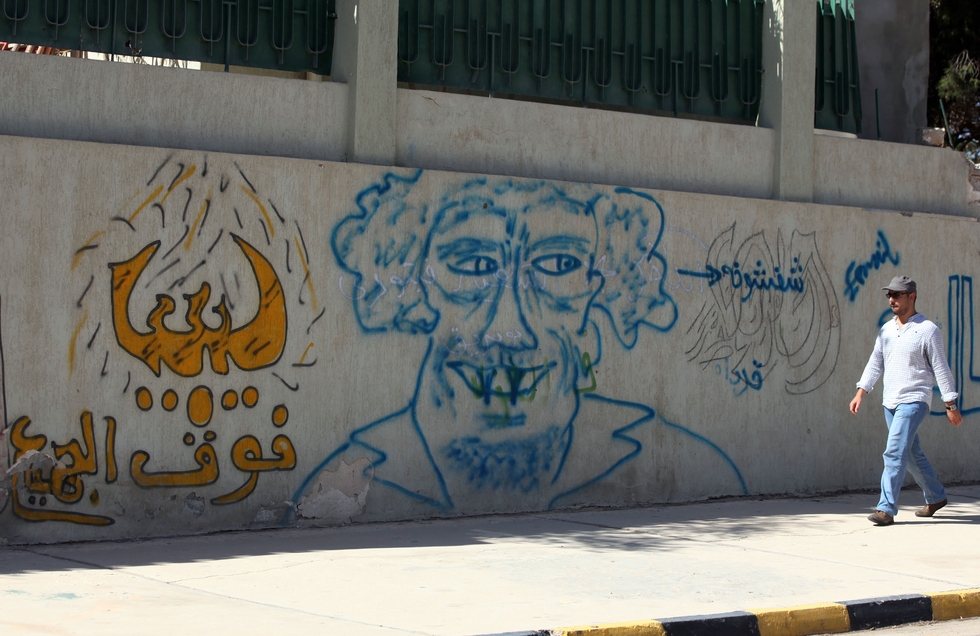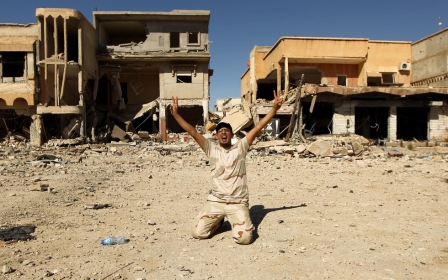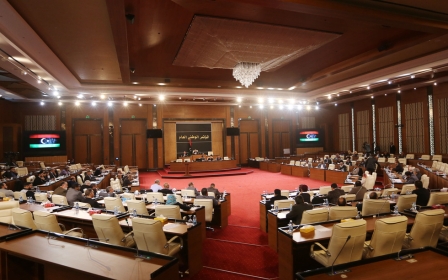Don't believe Libya's 'race to Sirte' rhetoric

The battle against the Islamic State (IS) in Libya has long been seen by supporters of the UN-mediated peace accord as the quintessential shared interest that could finally unify the country's discordant rival militias. Launching a coordinated attack on IS’s headquarters in Sirte would be a perfect way for new partners to embody their unity and engage in trust building.
Conversely, each militia claiming that only it can defeat IS and as such deserves arms and training from the international community is a perfect way for the rival militias to exacerbate the fault lines that divide them.
After Gaddafi, divisions multiply
Since the fall of Muammar Gaddafi in October 2011, militias have proliferated, while attempts at consolidating central governance have imploded. The forces which overthrew Gaddafi consisted of multiple uprisings - each animated by separate social and local interests - in addition to some extremists who joined the bandwagon. These forces were only briefly united in 2011 by their desire to oust the tyrant. Since then, they have fractured into mutually antagonistic components, unable to unite behind a common vision for the future.
Consequently, Libya lunges from crisis to crisis. The World Bank predicts that the Libyan Central Bank will be completely bankrupt by 2019. Most major cities are already facing electricity and medical shortages. With temperatures currently rising, there is a surge of African migrants transiting the country on their way to Europe. Assassinations and kidnappings for ransom have become commonplace. Criminal syndicates operate openly.
All this chaos promotes external interference. Western powers are eager to send special ops and bombers to attack IS, while Egypt and its allies are calling for the lifting of the arms embargo. In the meantime, they would like to circumvent the embargo by sending military assistance to their ally General Khalifa Haftar through Benghazi's Benina airport - if it reopens.
To arrest the freefall and sidestep the broken UN process, it would be ideal if the various mainstream militias could reunite against a new common enemy - IS. A true unity government can only be forged via a bottom-up consensus, not top-down impositions.
The only real victory against IS to date has been in Derna - IS's first strong hold in Libya. Last month, IS withdrew from the city after a year of intense battles against a coalition of non-IS jihadists and Haftar's LNA. In fact it is the only area in Libya in which an anti-IS coalition can be said to have operated effectively. Now is the time to build on this alliance, creating a patchwork of local anti-IS coalitions across the country.
Current developments reveal this hope as a pipedream. The militia divisions which have destabilised Libya for four years are intensifying. Over recent weeks, long standing political divisions amongst the militias reasserted themselves prior to the advent of any battle against IS in Sirte - ensuring that if such a battle materialises it will be a competitive rather than a cooperative effort.
The presidential council of the UN-mediated Government of National Accord (GNA) and its affiliated, mainly Misratan, militias and the opposing Libyan National Army (LNA) led by General Haftar have initiated a rhetorical race for Sirte. The Misratans and the LNA are the two main military forces inside Libya; they each appear poised to use the fight against IS to further their own dominance as well as to signal to the international community that they alone are the most trusted partner for confronting IS. This petty jockeying is likely to completely prevent the emergence of a genuine anti-IS coalition able to coordinate an attack on Sirte or administer conquered territory.
On 3 May, prospects for a unified Libyan army command to "liberate" Sirte were dashed, after the LNA clashed with Misratan-aligned forces 25 km west of Zillah - a town near Sirte. LNA units based in the town came under attack by forces allied to Misrata. The LNA managed to push back the attacking forces and has retaken Zillah. All this fighting occurred without IS suffering a single casualty.
Over the past two years a cold war between Misrata and Haftar has persisted. This drastic escalation at Zillah may indicate that the cold war has heated up and that it might overshadow the supposed “joint conflict” against IS.
Ill-fated attempts to unify rivals
Recognising the necessity to unite Libya's militias and bolster his own position, the UN-backed GNA Prime Minister-designate Fayez Al-Serraj made a televised address on 28 April. He sought to control the military momentum of the rival political factions moving toward Sirte.
Serraj pledged that a nationwide Libyan force unadulterated by foreign interference would liberate the city from IS control. Serraj’s speech came a day after the Misrata Military Council (MMC) released a statement recognising the GNA's presidential council as the supreme military commander of all Libyan armed forces on the condition that new military commands be appointed by the presidentla council according to the UN deal. This would assure that Haftar would lose his post.
And despite all these preparations, Misratan forces were caught on their heels. MMC forces positioned in Abu Grein 100km east of Misrata and 130km west of Sirte came under attack by IS suicide bombers last Friday. The Misratan response was a retreat.
On the same day, the PC issued a resolution establishing a special operations room for military operations against IS. Despite the convergence of military units of rival Libyan factions around Sirte for a supposed joint battle against IS, political divisions and these developments mean that the likelihood of conflict between rivals is far higher than that of a genuine assault on Sirte.
On the same day that the PC formed its special operation room, Haftar’s LNA issued a communique to all soldiers in the western region directing them to fall under the command of the LNA’s rival Western Region Operations Room. All parties claim to be interested in unity, but only if they are coordinating it and calling the shots.
This brings the number of rival Libyan "Sirte operation rooms" to three: one for Haftar’s LNA, one for the presidential council and another for the defunct Islamist-aligned, Tripoli-based General National Congress (GNC). In short, as each group claims rhetorically to be leading the charge towards Sirte, in actuality no one has attacked Sirte, withdrawals from previous established positions have taken place and zero coordinated action has materialised.
Fighting for oil does not foster unity
Ibrahim Jadhran, the Federalist leader and Haftar’s erstwhile military opponent in the east, was recently replaced as head of the Petroleum Facilities Guard. The move has further stoked tensions between the LNA and the Presidential Council, which has seemingly counted on Jadhran’s political support and military control over the key oil producing region.
In the wake of Jadhran's dismissal, the tensions between Eastern and Western Libya have burst out into the open. The rogue Eastern National Oil Corporation (NOC), which is not internationally recognised, blockaded the Hariga terminal in Tobruk on 4 May, preventing any oil from being loaded. This deprives the GNA government of much needed revenue and might foreshadow a struggle for control of the oil ports throughout eastern Libya.
Legally, the GNA-backed Western national oil company controls the ports but practically, the Tobruk-based eastern rogue NOC can deploy its loyalists on the ground. The oil standoff has resulted in a de-facto blockade of Hariga against all tankers exporting oil. As the tussle plays out, the blockade may extend to Brega and threatens to slash Libya’s exports and revenues even further.
Jadhran’s Federalist movement's control over the oil crescent is now greatly diminished, especially after the arrival of Libyan National Army special forces commander Wanis Bukhamada to effectively mediate the peaceful cooperation of the Petroleum Facilities Guard and the army in the region. This means that the new government and the international community have effectively lost control of Libya's oil region.
And as all sides wish to deny their opponents access to oil revenues, the Libyan economy is therefore caught in the crossfire. This makes the new government and the international community even more unpopular as Libyans face continued power shortages and belt-tightening as the elites jockey for position.
'My brother and I against my cousin, my cousin and I against the outsider'
The "race" to Sirte is a trope used by Libya's primary non-jihadist actors to whip up media frenzy attempting to gain international support. Each proclaiming their own righteousness, they attempt to weaken their traditional tribal and regional enemies denying them access to funds, arms and political support. No one can say if any serious fighting against IS will ever materialise. Even if certain militias do build up the gumption to attack Sirte, until a genuine coalition is formed, they are unlikely to be successful.
Western policymakers and regional states shouldn't trust their Libyan allies’ pronouncements that they are the "man for the job" to defeat IS. Results speak louder than words. And until now, claims to be confronting IS have only been dividing Libyans rather than uniting them.
- Jason Pack is the founder of EyeOnISISinLibya.com, President of Libya-Analysis, and the North Africa Analyst at Risk Intelligence.
The views expressed in this article belong to the author and do not necessarily reflect the editorial policy of Middle East Eye.
Photo: A Libyan man walks past graffiti of late Libyan leader Moamer Gaddafi is his hometown of Sirte on 13 October, 2012 (AFP).
Middle East Eye propose une couverture et une analyse indépendantes et incomparables du Moyen-Orient, de l’Afrique du Nord et d’autres régions du monde. Pour en savoir plus sur la reprise de ce contenu et les frais qui s’appliquent, veuillez remplir ce formulaire [en anglais]. Pour en savoir plus sur MEE, cliquez ici [en anglais].





